How to Make an Interactive PDF (with Examples & Tools)
Last updated: April 3rd, 2025
If you’ve ever opened a PDF and wished it could do more—like let you click, fill, watch, or interact—you’re thinking of an interactive PDF. These enhanced documents go beyond static pages, turning traditional brochures, presentations, and catalogs into engaging, clickable experiences. Whether you’re creating digital marketing content, onboarding materials, or product guides, using an interactive document can make your message more memorable and user-friendly.
That’s where interactive PDFs come in.
Unlike classic PDFs, interactive documents allow you to embed clickable links, buttons, videos, forms, and animations—turning a standard file into a dynamic, engaging experience. Whether you’re creating sales materials, educational content, onboarding documents, or digital publications, adding interactivity can transform how your audience consumes your content.
In this article, you’ll discover:
- What an interactive PDF is
- Examples of interactive PDFs across different industries
- How to make an interactive PDF using various tools
- And why it matters for marketing, UX, and content engagement
We’ll also explore interactive PDF creators, showcase interactive document examples, and provide interactive PDF samples you can draw inspiration from.

Table of contents
- What does an interactive PDF look like?
- How to create an interactive PDF with Flipsnack
- Interactive PDF examples for multiple industries
- 1. Real estate brochures with virtual tours
- 2. Simplify the buying process with an interactive e-commerce catalog
- 3. Create interactive employee benefit guides
- 4. Improve internal communications with interactive documents
- 5. Create eye-catching marketing materials
- 6. Simplify complex reports with interactive PDFs
- Other interactive PDF creators for different needs
- Turn static PDFs into interactive experiences with Flipsnack
- Frequently asked questions about interactive PDFs
As the name suggests, an interactive PDF is a PDF file enhanced with interactive elements that encourage user engagement. These can include clickable links, embedded video and audio widgets, quizzes, shopping lists, product tags, maps, social media buttons, or even animated GIFs. Despite these added features, the file remains a standard PDF format, meaning it still requires a regular PDF reader to open.
In contrast, a traditional PDF typically supports images, text and basic hyperlinks—but offers little beyond that in terms of interactivity.
The addition of interactive features not only improves the reader’s experience but can also support your business goals. For instance, a shopping list can streamline the purchasing journey, a well-placed video or audio clip can provide extra context, and an embedded form allows readers to subscribe directly to your email campaigns.
What does an interactive PDF look like?
Take a look at this PDF with a video example, browse through it, and engage with its dynamic elements. You, too, can add dynamic elements to PDFs when converted into flipbooks.
How to create an interactive PDF with Flipsnack
If you want to make your PDF interactive, know that there are interactive PDF creators such as Flipsnack that are super intuitive and easy to use.
You can either upload and turn your regular PDFs into flippable, interactive ones by adding elements using a drag-and-drop feature or use our Design Studio and create digital flipbooks from scratch without any prior design experience. Thanks to its intuitive drag-and-drop feature, it is easier to use than other similar products, such as Adobe InDesign, for example.
To make your PDF interactive, all you need to do is upload it to Flipsnack and add all the elements you need.
But before that, you must prepare your document. This includes:
- Getting inspired for your mood board
- Editing your product pictures
- Creating the document in InDesign
- Choosing the right layout
- Designing your PDF
When designing your layout, think about all the placeholders so you can easily drag and drop videos, photo slideshows, and other dynamic elements to the PDF flipbook.

Here is how Flipsnack can help you create a digital flipbook by adding interactivity to your PDF files:
Step 1: Upload the PDF in Flipsnack or start from scratch
Once your layout is ready for interactive elements, it’s time to bring it into Flipsnack. You can upload your PDF by simply dragging and dropping it into the editor. Whether you’re working with a single document or multiple files, Flipsnack makes it easy—upload one at a time, or choose the bulk option to either merge them into a single PDF or keep them as separate files.
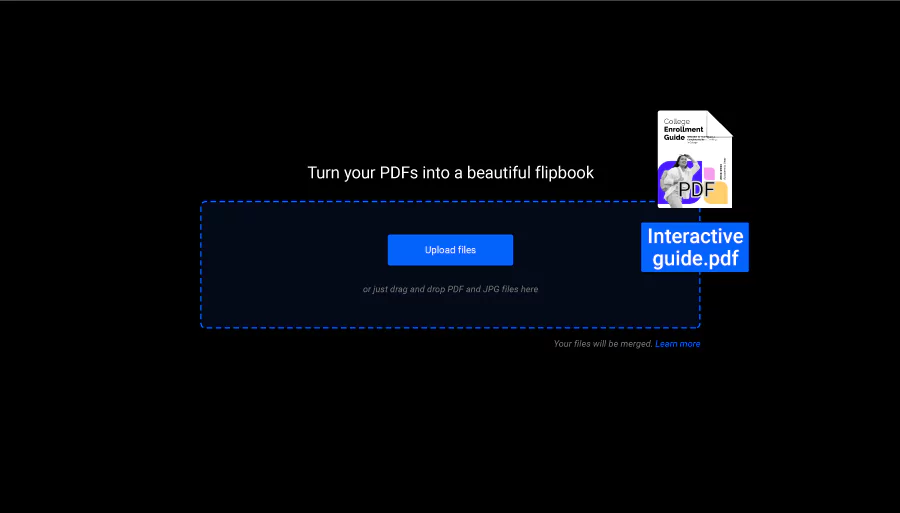
If you don’t have a ready-made PDF, you can create interactive flipbooks using the Design Studio or choose an interactive template available in Flipsnack.
Step 2: Add interactive elements to your PDF flipbook
Now it’s time to make your content come alive. Inside Flipsnack’s editor, you can add interactive elements to customize your PDF flipbook and create a richer reading experience. Simply drag the elements onto your pages—then resize, reposition, and edit their properties to fit your design.
For example, in this college enrollment guide, we included:
- A video widget that plays content directly within the page
- A caption button that reveals extra information—like details on standardized tests—without cluttering the layout
- Social media buttons that link to platforms like Facebook, Instagram, or YouTube, making it easy for readers to connect or explore further
These small touches make your document more dynamic and user-friendly—while keeping everything in one seamless, scroll-free experience.
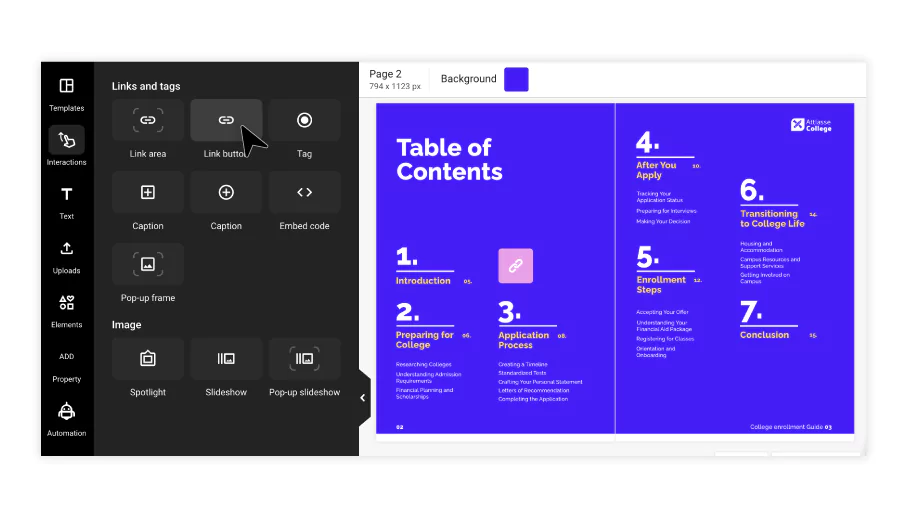
Step 3: Customize and brand your interactive publication
Once you’ve added your interactive elements, it’s time to make the publication truly yours. Start by uploading your logo, and—if you want to drive traffic—link it to your official website or any other important destination.
To further align your flipbook with your brand identity, you can:
- Choose a player accent color that matches your brand palette
- Enable the flip sound effect for a tactile reading experience
- Activate the accessibility feature to ensure the content is inclusive
- Add a lead form to collect reader information or generate conversions
These finishing touches not only enhance the visual appeal of your PDF but also strengthen brand consistency and increase engagement.
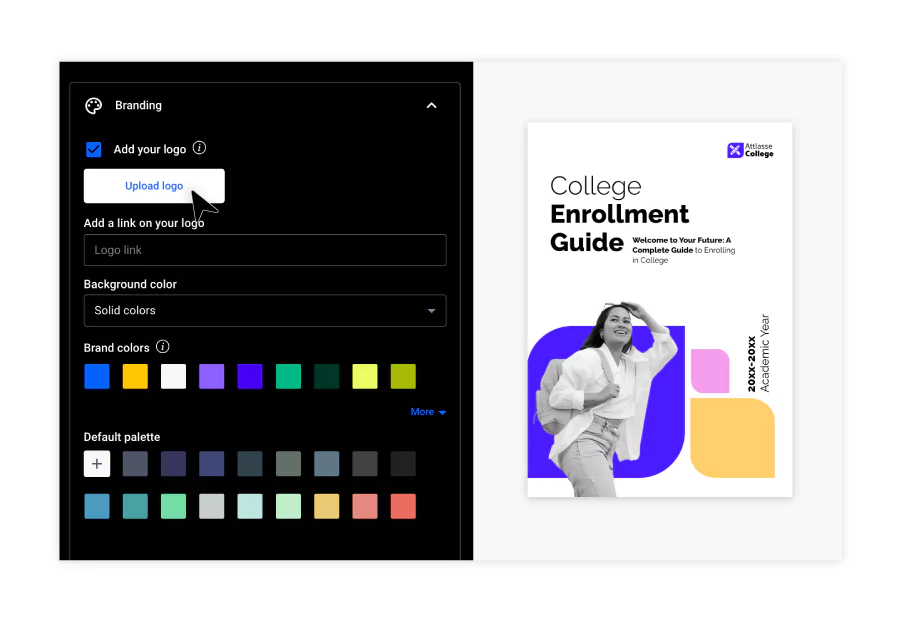
Step 4: Publish your PDF Flipbook — public or private
When you’re ready to share your interactive PDF, Flipsnack lets you choose how it’s accessed. You can publish it publicly for anyone to view, or keep it private with more restricted access.
Depending on your needs, you can:
- Password-protect the flipbook
- Share it with specific people only
- Keep it unlisted so only those with the link can access it
These privacy options give you full control over who sees your content—whether it’s a public marketing brochure or an internal company document.
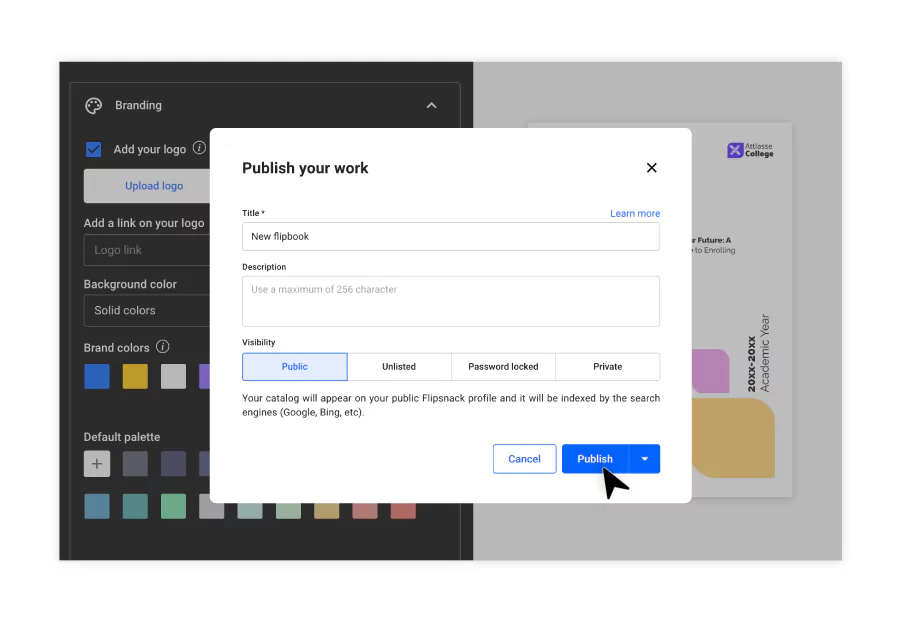
Step 5: Share the link to your interactive PDF
Once your interactive PDF is ready, sharing it is effortless. Flipsnack provides multiple ways to distribute your content based on your audience and goals.
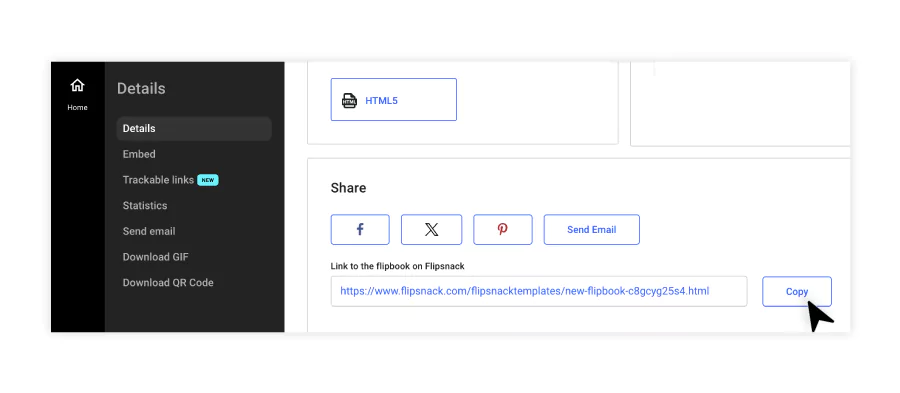
You can:
- Share a direct PDF link
- Send it via email
- Post it on social media
- Embed it directly into your website or blog
Want to generate buzz or give a quick preview? You can also share a GIF or short video snippet of your flipbook to catch attention and drive clicks.
No matter how you choose to share, your content stays interactive, polished, and accessible across any device.

Interactive PDF examples for multiple industries
Standard PDFs are great for presenting information, but they’re often static and uninspiring. With limited design and no built-in interactivity, they can feel more like print documents on a screen—easy to skim, easier to ignore.
Interactive PDFs change that. By embedding clickable elements like videos, navigation buttons, image carousels, or pop-ups, you can create a dynamic reading experience that holds attention and encourages action. From marketing brochures to internal documents, interactive PDFs offer a more engaging, user-friendly alternative.
Let’s explore a few real-life interactive PDF examples that show what’s possible.
1. Real estate brochures with virtual tours
Imagine you’re a real estate agent selling a home and sending out a PDF brochure to potential buyers. A traditional PDF might include a few property photos, some text about the features, and maybe a link to your website. That’s helpful—but limited.
Now picture an interactive real estate brochure: users can take a virtual tour of the house right from the PDF. They can click through rooms, view 360° panoramas, and access extra details about the construction, neighborhood, or nearby amenities—all without leaving the document.

This type of interactive PDF not only gives buyers a better sense of the property but also shortens the decision-making process by offering everything they need in one place.
2. Simplify the buying process with an interactive e-commerce catalog
If you run an e-commerce store and regularly send out product catalogs or promotional PDFs, you know how clunky the experience can be for the customer. A traditional PDF forces them to jump back and forth between the file and your website—searching for products, adding them to their cart, and navigating multiple tabs just to complete a simple task.
That’s where an interactive PDF catalog can make a real difference.

By embedding clickable shopping buttons or product overlays directly into the catalog, users can add items to a shopping list while they browse—without ever leaving the document. This streamlined experience keeps them engaged longer and reduces friction in the buying process.
At the end of the interaction, customers can download or submit their list for a quote, a wishlist, or a pre-filled order form. It’s a faster, more intuitive way to shop—and one that respects your audience’s time and attention.
3. Create interactive employee benefit guides
Static PDFs just don’t meet the expectations of today’s employees—especially when it comes to understanding complex topics like health plans, perks, or retirement options. People want fast, intuitive, and mobile-friendly access to information they can actually interact with.

That’s why many HR teams are turning to interactive employee benefit guides. These modern documents replace dense, text-heavy PDFs with a dynamic experience that includes clickable sections, pop-up explanations, embedded videos, and real-time updates. Employees can easily find what they need, explore details at their own pace, and stay engaged throughout the process.
And it’s not just a win for employees—it simplifies things for companies too. For HR professionals, brokers, or benefits admins, managing multiple versions of a guide can be a hassle. But with tools like Flipsnack, you can convert static PDFs into interactive digital flipbooks that are easy to update, customize for different teams or locations, and share securely—without starting from scratch every time.
Let’s look at PINEYWOODS customer success story to understand just how much interactive PDFs can help your business.
Switching from printed materials to digital flipbooks cut their costs by 80% while adding value through features like embedded links, videos, and custom branding. These guides impressed clients, improved relationships, and helped win new business.
With a 100% adoption rate, PINEYWOODS Benefits proves how interactive PDFs can transform how businesses connect with clients.

4. Improve internal communications with interactive documents
When it comes to internal communications, interactive PDFs can be a game-changer. Whether you’re in HR, management, or operations, sharing updates, policies, or training materials doesn’t have to mean sending out a wall of text in a static PDF.
Instead, consider using interactive documents—such as digital flipbooks—that make communication clearer and more engaging. Need to roll out a new policy? You can include a video message from the CEO, link to supporting resources, and even embed an interactive Q&A section—all in the same document. Employees can read, watch, and interact with content in one seamless experience.

For onboarding or training, add built-in quizzes and feedback forms. This keeps employees engaged and allows you to gather insights in real time, without needing separate tools or email follow-ups. It’s a smart, efficient way to streamline internal messaging and boost retention.
5. Create eye-catching marketing materials
Let’s be honest—most marketing PDFs tend to blend into the background. But with an interactive PDF brochure or flyer, you have the chance to create something that potential customers enjoy reading and flipping through.
Take your product catalog, for example. Instead of static pages filled with text and pricing tables, you can turn it into an interactive product catalog that includes product demo videos, clickable buttons that drive users straight to your site, and embedded features that streamline the path from browsing to buying. No extra clicks. No friction. Just a clear, engaging experience.

Need to showcase results? Use an interactive case study. Instead of a static PDF filled with paragraphs of text, you can embed testimonial videos, clickable data charts, and call-to-action buttons that guide prospects to your website or contact form. It’s a more dynamic and persuasive way to demonstrate impact—one that builds trust and makes your brand stand out. An AI video generator can help you quickly create product demos or testimonial clips to embed directly into your interactive PDFs, making your materials even more engaging and effective.
6. Simplify complex reports with interactive PDFs
If your role involves preparing detailed documents—like financial reports, research papers, or performance summaries—you know how overwhelming they can be for readers. A dense wall of text and static visuals doesn’t exactly encourage engagement.
With features like a clickable table of contents, internal navigation links, and interactive charts, you can transform a traditional report into a navigable, interactive document. Take an annual financial report, for instance: instead of scrolling through dozens of pages, readers can jump directly to the sections they care about, explore dynamic charts, or click through footnotes and references without losing their place.

Other interactive PDF creators for different needs
While Flipsnack is a powerful and user-friendly platform for creating interactive PDFs, it’s not the only option out there. Depending on your business goals, team size, or technical requirements, you may want to explore other tools that specialize in different types of interactive content. Here are four great alternatives to consider—each suited for a specific use case:
1. Adobe InDesign – Best for advanced designers and creative teams
If you’re looking for full creative control and need to design highly customized marketing materials, Adobe InDesign is the go-to. It allows you to create print-quality layouts and add interactive elements such as buttons, hyperlinks, embedded media, and animations.
- Ideal for: Designers, publishers, agencies
- Great for: Interactive brochures, magazines, digital reports
- Bonus: Seamless integration with other Adobe Creative Cloud tools
2. Wondershare PDFelement – Best for form-based interactivity
If your interactive PDFs revolve around data collection, signatures, or fillable forms, PDFelement is a solid choice. It offers robust form-building tools along with options to embed video, add links, and secure documents.
- Ideal for: Corporate teams, HR departments, legal & finance professionals
- Great for: Contracts, onboarding packets, training materials
- Features: Fillable fields, OCR, password protection, export options
3. Scribus – Best open-source alternative for custom layouts
If you need a free solution and have some design experience, Scribus is a strong open-source alternative. It offers layout precision and supports interactive PDF features like form fields and JavaScript-based actions.
- Ideal for: Nonprofits, educators, startups on a budget
- Great for: Reports, academic materials, digital handbooks
- Strength: Free and open-source with strong layout capabilities
4. Foxit PDF Editor – Best for enterprise document workflows
Foxit PDF Editor offers robust tools for editing, securing, and making PDFs interactive—perfect for companies that prioritize efficiency and data protection. It supports form fields, buttons, rich media embedding, and document collaboration features.
- Ideal for: Corporate teams, legal, finance, government
- Great for: Contracts, policies, reports, client onboarding docs
- Strength: Enterprise-grade security, form creation, redaction tools
Turn static PDFs into interactive experiences with Flipsnack
Interactive PDFs aren’t just a design trend—they’re a smarter way to present your brand, tell your story, and connect with your audience. By embedding videos, buttons, forms, and other engaging elements, your documents become more than just something to scroll through—they become something to explore.
Whether you’re in e-commerce, marketing, or corporate communications, interactive flipbooks can help you deliver information in a way that’s memorable, effective, and on-brand. And with Flipsnack, creating these digital experiences doesn’t require advanced design skills or complicated software.
You can upload your PDF, add interactivity, brand it, and publish it—all in a matter of minutes. The end result? A sleek, professional-looking document your audience will actually want to engage with.
So why settle for static, when you can flip, click, and captivate?

Frequently asked questions about interactive PDFs
A standard PDF is a static document, while an interactive PDF includes elements like clickable buttons, hyperlinks, videos, and fillable forms, making it more engaging.
Use a tool like Adobe Acrobat, Canva, or Flipsnack to add hyperlinks and buttons to your PDF. This allows users to navigate easily within the document or to external websites.
With software like Flipsnack, you can add form fields, checkboxes, and other interactive elements to your PDF, making it fillable.
Organize your content logically and use clear, clickable elements like buttons and links to make it intuitive and easy to navigate.
Balance interactivity with aesthetics by using a clean layout, consistent fonts, and colors that enhance the readability of your interactive file without overwhelming the user. Use your brand kit to maintain consistency.
Include tags for screen readers, use a logical reading order, and ensure that all interactive elements are keyboard accessible.
Integrate relevant keywords naturally in the text, file name, and alt text for images. Also, set a title, subject, and keywords in the document properties.
Share your PDFs on social media, embed them on your website, and include them in email marketing campaigns to reach a wider audience.
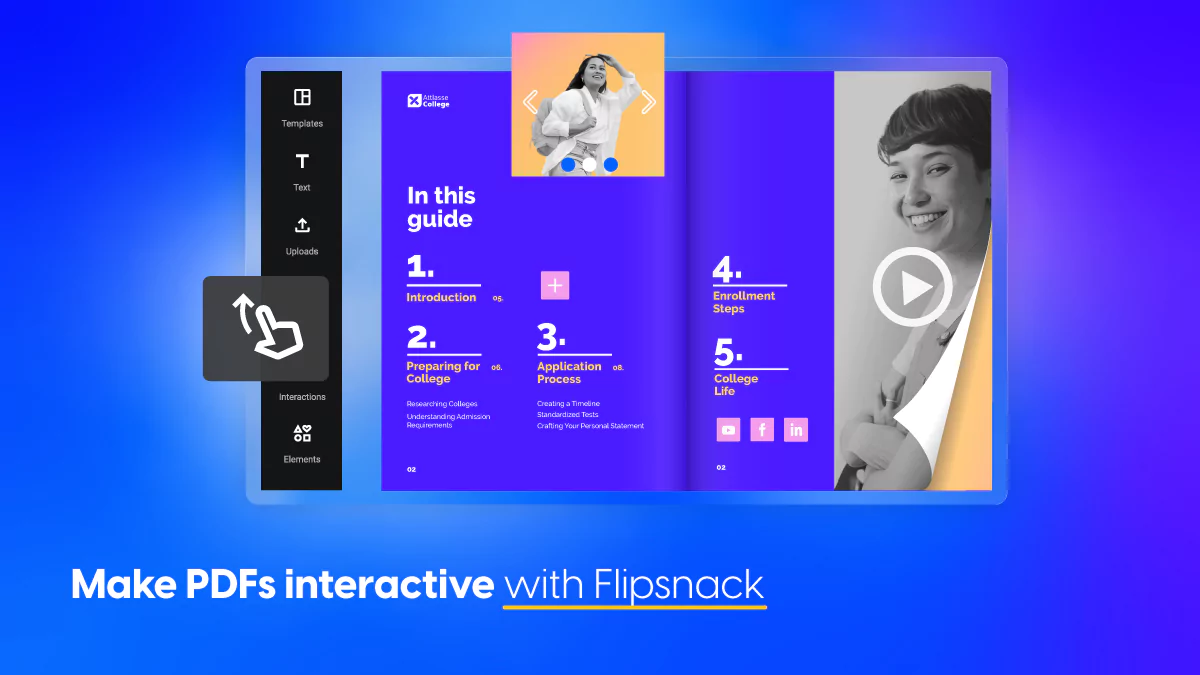
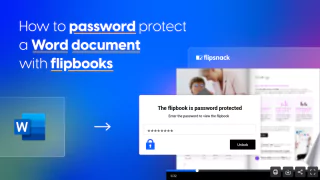
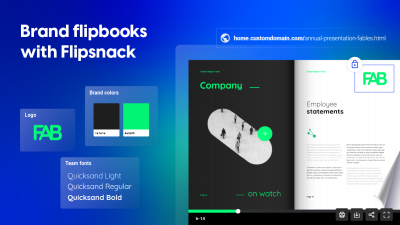
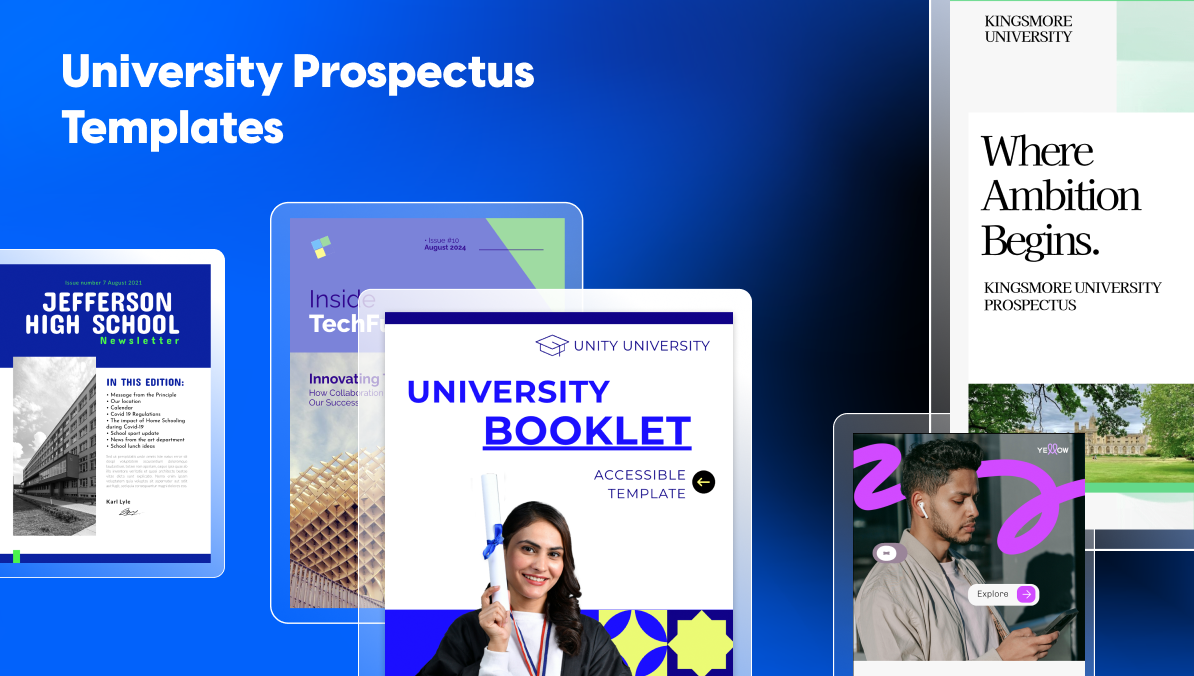
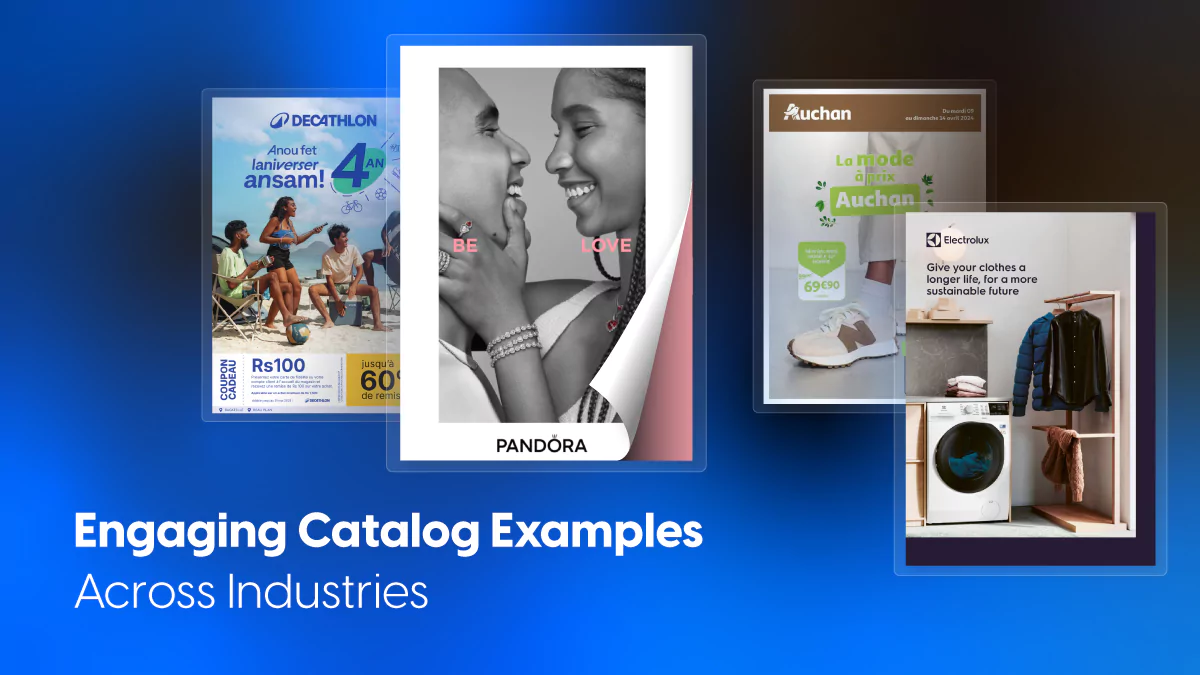

[…] you can even upload a ready-made PDF to Flipsnack and we will turn it into a beautiful page-flip document that’s highly […]
Can I dowload it and see it in my pc normally or do I have to have an especial reader for it?
You can view it directly in browser, you don’t need any special readers for it.
Could Flipsnack be a useful tool for creating exam sheets? As a lecturer in higher education, I have found online teaching and creating exam or short test sheets to be handed in online a challenge. I am thinking about buying Adobe, but I agree that it is a bit over my budget and I probably would not make use of it for my money’s worth. That is why I am intrigued about your product. Could you help me, please? Could you tell me more about Flipsnack and creating exams, tests, and surveys, please?
Hello Stan, thank you for your questions. There is a way to integrate exams, tests, and surveys in Flipsnack, by embedding them. You would first need to create your tests or surveys on a website such as this one for example https://www.typeform.com/test-maker/, and then simply embed the code in the exam sheet you’re creating in Flipsnack. Here is an article that covers the subject in more detail: https://blog.flipsnack.com/add-iframe-widgets-in-flipbooks/. In case you have any more questions, please contact us via live chat.